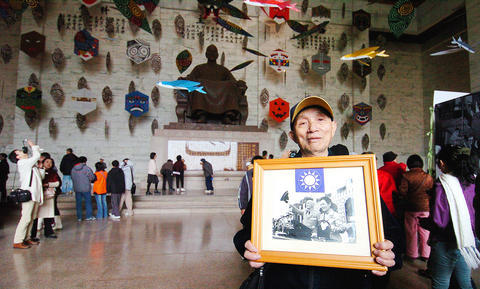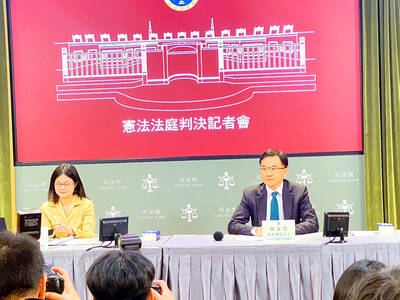National Taiwan Democracy Memorial Hall reopened to the public yesterday, with the 10m high statue of dictator Chiang Kai-shek (蔣介石) remaining in the lobby of the hall, which has been decorated with kites to reflect the theme of "a democratic wind."
Amid sporadic shouting outside the hall, President Chen Shui-bian (陳水扁) delivered the opening speech inside the heavily guarded building yesterday morning, saying that the name change of the hall and new inscription on the main arch signified that authoritarianism had ended and that an era of freedom and democracy had begun.
"Freedom and democracy have become part of our life, like the air we breathe each day," he said. "They do not come easily, however. Our ancestors fought for them, sacrificing their personal safety and even their lives."

PHOTO: GEORGE TSORNG, TAIPEI TIMES
The renaming of the hall, which was carried out under the auspices of the Ministry of Education, met with strong opposition. The inscription on the gateway -- dazhong zhizheng (大中至正), referring to Chiang's "great neutrality and perfect uprightness" -- was subsequently replaced with "Liberty Square."
Chen said the name change and the two exhibitions that opened at the hall yesterday would remind people that democracy and liberty come at a price and that Taiwanese must cherish those hard-earned achievements.
Ahead of the opening yesterday, there had been speculation that the administration would dismantle the statue or cover it up. Chen said the government would do neither.
Chen said that since the Democratic Progressive Party (DPP) came to power in 2000, his administration had made every effort to remove relics of authoritarianism.
During his term as Taipei mayor, Chen said, he changed Chiehshou Road's (介壽路) name to Ketagalan Boulevard to demonstrate his goodwill toward Aborigines and renamed Taipei New Park to 228 Peace Park -- in commemoration of the government crackdown on the civilian uprising that became known as the "228 Incident."
During his presidency, Chen replaced a sign that had hung over the entrance to the Presidential Office since 1948 -- Chiehshou Hall (介壽館) -- with a new sign that simply read "Presidential Office."
Chen said the reopening of the hall symbolized the "opening of the door of democracy" and that it transformed "a temple" worshipping a dictator to a venue where all people can freely reflect and learn the true meaning of democracy and human rights.
"We believe history will speak for itself and people will learn from history," he said. "That is the true meaning of the reopening."
Ministry of Education Secretary-General Chuang Kuo-jung (莊國榮), who had floated the idea of covering up the statue, yesterday said that it was one of the many options the ministry had considered.
The main hall, where the statue stands, is decorated with kites and large posters featuring themes from the nation's democratic movement.
The kites represent achieving freedom, Chuang said, like a butterfly that emerges from its cocoon.
He said the decorations cost about NT$1 million (US$31,000), substantially less than the price of the statue -- NT$23 million -- and the building itself -- NT$1.2 billion.
Asked about Vice President Annette Lu's (
Tu asked reporters attending the opening ceremony to decide for themselves whether the changes to the hall were worthy of praise or not.
"The way various media outlets report on today's event will be an indication of the development of media freedom and neutrality in the 20 years since the lifting of martial law," he said.
At an election rally event on Saturday in Jhonghe (
Chueh Feng-shih (闕豐實), a 67-year-old Taipei resident invited by the organizers to attend the ceremony, said he felt sad when he saw the names of all the victims of the 228 Incident posted on the wall.
He did not think the statue of Chiang should be removed. The statue can serve as a reminder to the public of the atrocities that Chiang committed during his rule, Chueh said.
Another guest, who identified herself only as Mrs Chen, agreed, saying that it was only right to educate the public both about the dictator's crimes and his contributions.
Her husband, Mr Su, however, said the statue should be melted, made into a missile and used against China.
Additional reporting by Jenny W. Hsu

The US government has signed defense cooperation agreements with Japan and the Philippines to boost the deterrence capabilities of countries in the first island chain, a report by the National Security Bureau (NSB) showed. The main countries on the first island chain include the two nations and Taiwan. The bureau is to present the report at a meeting of the legislature’s Foreign Affairs and National Defense Committee tomorrow. The US military has deployed Typhon missile systems to Japan’s Yamaguchi Prefecture and Zambales province in the Philippines during their joint military exercises. It has also installed NMESIS anti-ship systems in Japan’s Okinawa

TRAGEDY STRIKES TAIPEI: The suspect died after falling off a building after he threw smoke grenades into Taipei Main Station and went on a killing spree in Zhongshan A 27-year-old suspect allegedly threw smoke grenades in Taipei Main Station and then proceeded to Zhongshan MRT Station in a random killing spree that resulted in the death of the suspect and two other civilians, and seven injured, including one in critical condition, as of press time last night. The suspect, identified as a man surnamed Chang Wen (張文), allegedly began the attack at Taipei Main Station, the Taipei Fire Department said, adding that it received a report at 5:24pm that smoke grenades had been thrown in the station. One man in his 50s was rushed to hospital after a cardiac arrest

ON ALERT: Taiwan’s partners would issue warnings if China attempted to use Interpol to target Taiwanese, and the global body has mechanisms to prevent it, an official said China has stationed two to four people specializing in Taiwan affairs at its embassies in several democratic countries to monitor and harass Taiwanese, actions that the host nations would not tolerate, National Security Bureau (NSB) Director-General Tsai Ming-yen (蔡明彥) said yesterday. Tsai made the comments at a meeting of the legislature’s Foreign Affairs and National Defense Committee, which asked him and Minister of National Defense Wellington Koo (顧立雄) to report on potential conflicts in the Taiwan Strait and military preparedness. Democratic Progressive Party (DPP) Legislator Michelle Lin (林楚茵) expressed concern that Beijing has posted personnel from China’s Taiwan Affairs Office to its

‘ILLEGAL RULING’: The KMT and the TPP slammed the Constitutional Court judgement, saying it contravened the law and was trying to clear the way for a ‘green dictatorship’ The Constitutional Court yesterday ruled that amendments to the Constitutional Court Procedure Act (憲法訴訟法) passed by the Legislative Yuan last year are unconstitutional, as they contravene due legislative process and separation of powers. The Legislative Yuan on Dec. 20 last year passed amendments stipulating that no fewer than 10 grand justices must take part in deliberations of the Constitutional Court, and at least nine grand justices must agree to declare a law unconstitutional. The Executive Yuan on Jan. 2 requested that lawmakers reconsider the bill, but the Legislative Yuan, under a combined majority of Chinese Nationalist Party (KMT) and Taiwan People’s Party